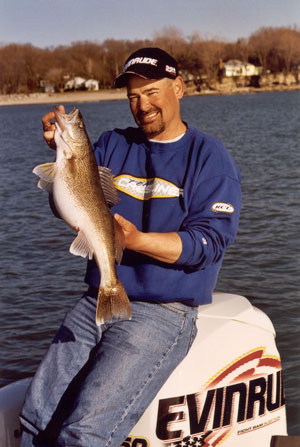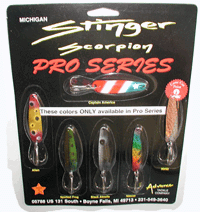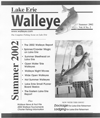What do early season walleyes really want? The answer may surprise you!
You
 might
think itís a jig, or a jig tipped with a minnow, or a live bait rig, and
that could very well be. On the other hand there might be something in your
tackle box that if given a chance could prove to be absolutely deadly, but
is being completely overlooked. So what is it? Why itís a crank bait of
course, but not just any old bait.
might
think itís a jig, or a jig tipped with a minnow, or a live bait rig, and
that could very well be. On the other hand there might be something in your
tackle box that if given a chance could prove to be absolutely deadly, but
is being completely overlooked. So what is it? Why itís a crank bait of
course, but not just any old bait.
Early season means colder water temps and cold water walleyes have needs,
needs that have to be addressed. Cold generally means slow, like a slower
metabolism and a world thatís moving in slow motion. With that in mind it
would be a good idea to select a bait that can perform at slower speeds, and
only the few and proud can actually fit the bill.
Balsa baits like the original Rapala have what it takes to produce a fish
attracting wiggle at even the slowest speeds, giving them an edge over most
other baits. The buoyancy of balsa combined with the long slim profile and
tiny diving lip of a Rapala creates an unmatched balance that allows the
user to work at a snails pace, well almost.
An exception to the rule is the Jointed Shad Rap, which can definitely
produce at slower speeds. Its hinged middle section gives the bait an
enticing wiggle, and has the added attraction of rattles that are
accentuated by the unusual action.
Other plastic cranks like Storm Thundersticks can produce at all but the
slowest of speeds, and definitely get noticed as they too have built in
rattles. The Shad Rap is another fantastic balsa bait but requires a little
more speed to be effective and is the next lure in line on the early season
"go to list," especially when water temps begin to warm up a bit. The Shad
Rap really comes into its own when you move beyond the spawn, and can be
counted on to get the job done throughout the rest of the open water season.
The one thing in common with most of these baits is the fact that they
are shallow runners and early season walleyes arenít always holding in
shallow water. In fact they can be plenty deep, especially right after
ice-out. On Lake Francis Case (a big reservoir in South Dakota) for example,
walleyes will often hold in twenty to thirty feet of water or more early in
the open water season. Sure there are deep diving crank baits designed to
hit that depth on a given trolling run but they lack the attractiveness of a
shallow running bait.
The solution is to run a shallow diver in deep water, but that does
require a change or two in the standard trolling tactics. Options include
using inline weights ahead of the lure, or trying a weighted line like
leadcore.
Leadcore has the edge when it comes to precision as you can specifically
target within a six or twelve inch window of the bottom, and do so with
nothing but the bait entering that particular zone. It also provides the
ability to track your bait and know if itís constantly banging into the
bottom or running clean.
Because leadcore possesses little stretch, the stop and go of a bait
digging into the bottom is transferred back to the rod tip. By watching the
tip you can adjust the amount of line you have out and know just how close
youíre running at any given time. The combination of leadcore line and a
shallow running bait gives you flexibility, and flexibility is good. This
set up allows you to troll through shallow when you want, or deep when you
feel the need, and do so without changing baits or lines. Again, getting
back to Lake Frances Case; Early season walleyes will often move up into ten
feet of water or less under the right conditions, and yet may be pushed back
down into thirty feet or more like after a cold front pushes through. You
never know for sure just where theyíll be and you have to be able to get to
it all to be effective. A presentation that lets you run both shallow and
deep would be ideal, and is why leadcore is the preferred method for
trolling up early season walleyes.
You can do it all by simply letting out or taking in more line, and then
watching your rod tip to make sure youíre bait is running where you want it
to be. Another advantage to the leadcore program is the ability to use
smaller baits, and small is often what giant walleyes are looking for.
The basic set up consists of a longer casting rod with a medium light
action tip in the eight to nine foot range, coupled with a large capacity
reel loaded with leadcore line. The light action tip is soft enough to
expose the details of a properly running bait and because of its bulk you
simply canít get enough leadcore on a standard sized reel, especially if
youíre going to be working deeper water.
An eight or nine foot leader separates the leadcore from the bait and is
fastened to the line with a small #18 barrel swivel. The tiny swivel will
help keep line twist to a minimum and can actually be reeled through the
guides and into the reel without a lot of trouble.





 might
think itís a jig, or a jig tipped with a minnow, or a live bait rig, and
that could very well be. On the other hand there might be something in your
tackle box that if given a chance could prove to be absolutely deadly, but
is being completely overlooked. So what is it? Why itís a crank bait of
course, but not just any old bait.
might
think itís a jig, or a jig tipped with a minnow, or a live bait rig, and
that could very well be. On the other hand there might be something in your
tackle box that if given a chance could prove to be absolutely deadly, but
is being completely overlooked. So what is it? Why itís a crank bait of
course, but not just any old bait.